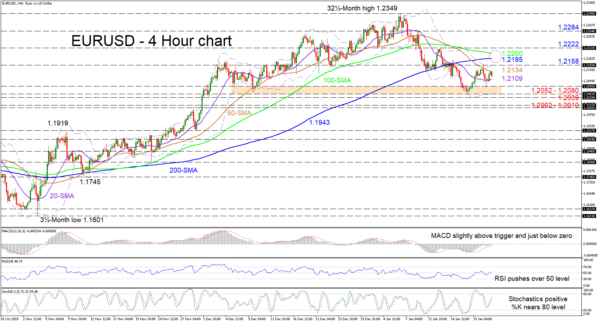EURUSD’s recent bounce within a key support region, after a deep retraction below the 200-period simple moving average (SMA), seems to be curbed by the 50-period SMA. Promoting a paused bearish plunge is the falling 50-period SMA and the slight upturn in the 20-period SMA. Furthermore, the gliding 100-period SMA and the slowing upward pace of the 200-period SMA are suggesting further weakening in the positive structure.
Taking a glimpse at the short-term oscillators, it is apparent that positive momentum is struggling. The MACD, marginally below zero and a tad above its red trigger line, seems unable to push above the neutral mark, while the RSI is zig zagging around its 50 level, trying to sustain a push into bullish territory. Yet, the stochastic oscillator is improving, suggesting more positive price action.
In a negative scenario, initial downside friction could occur at the 20-period SMA at 1.2109 ahead of a critical support foundation of 1.2052-1.2080, containing multiple troughs. In the event the decline extends underneath the lower Bollinger band, residing at the lower end of the aforementioned support base, adjacent constrictions could arise from the 1.2039 barrier. Sinking past this too, the bears may challenge the 1.2002-1.2010 support boundary.
Otherwise, if buyers manage to step above the capping 50-period SMA at 1.2134, the price could meet the 1.2158 nearby resistance. Successfully clearing the upper Bollinger band, the pair may then test the heavy 200- and 100-period SMAs at 1.2185 and 1.2200 respectively, prior to the 1.2222 high. Additional gains from here could seek cover at the 1.2284 boundary.
Overall, in the short-term, the pair’s decline seems subdued as long as the price remains above 1.2052 trough. Moreover, the pair’s confidence may be restored should the price return above the 200-period SMA and the 1.2222 mark.














